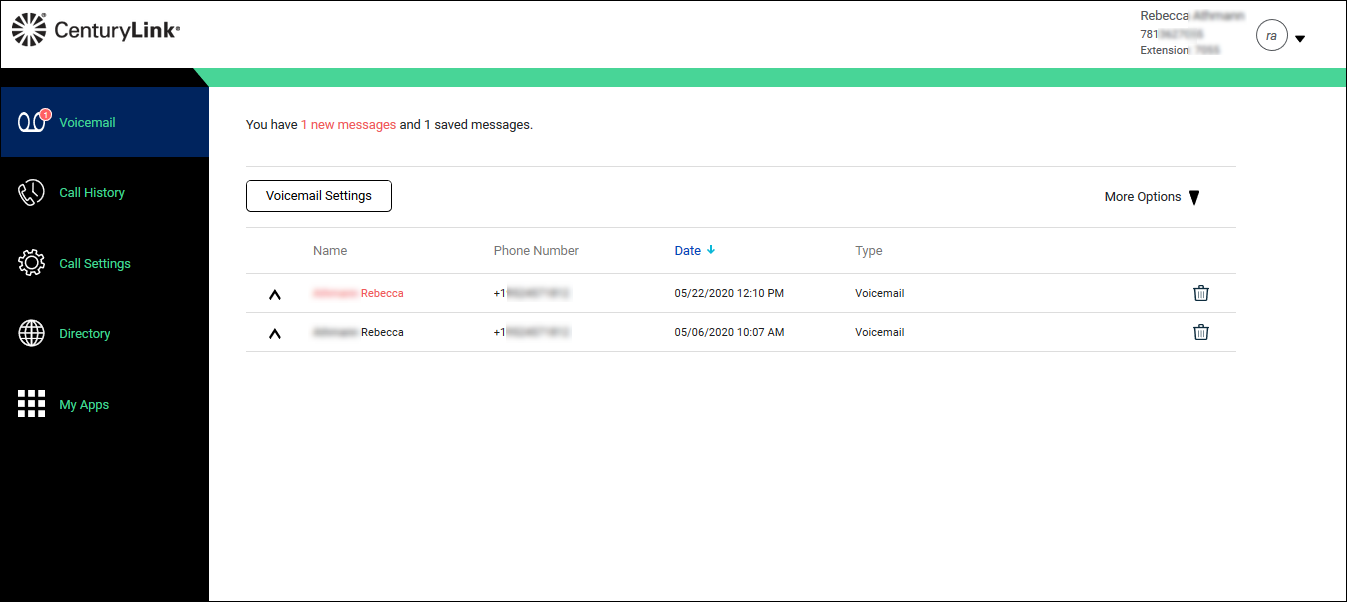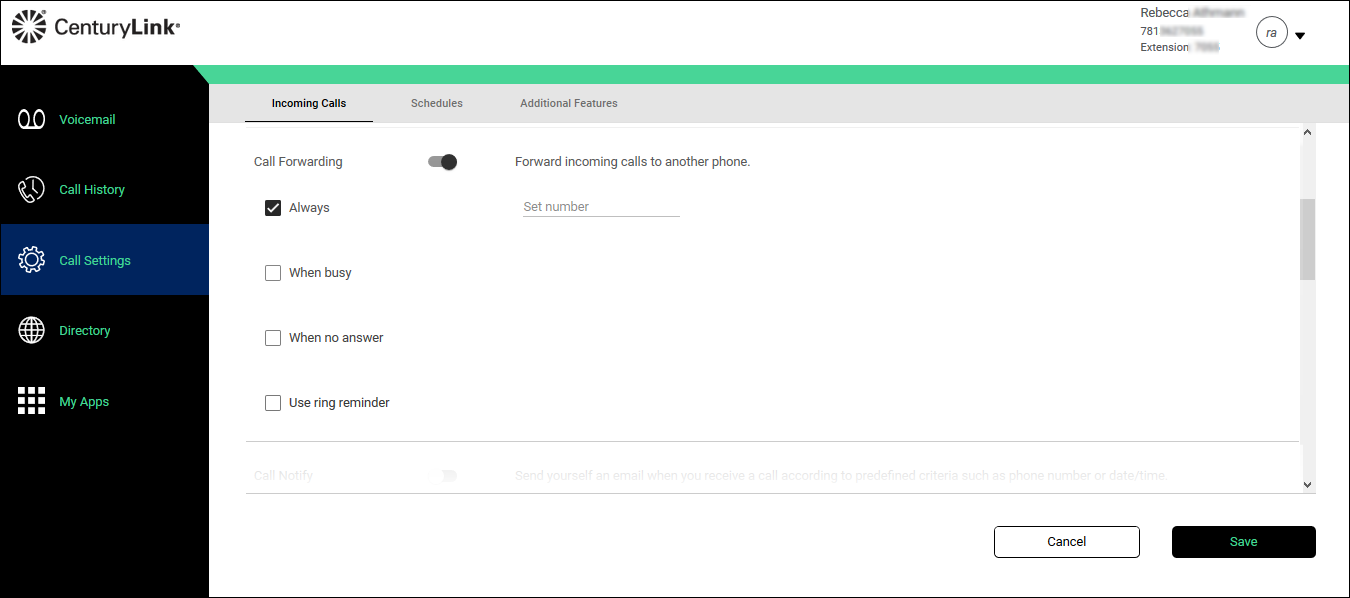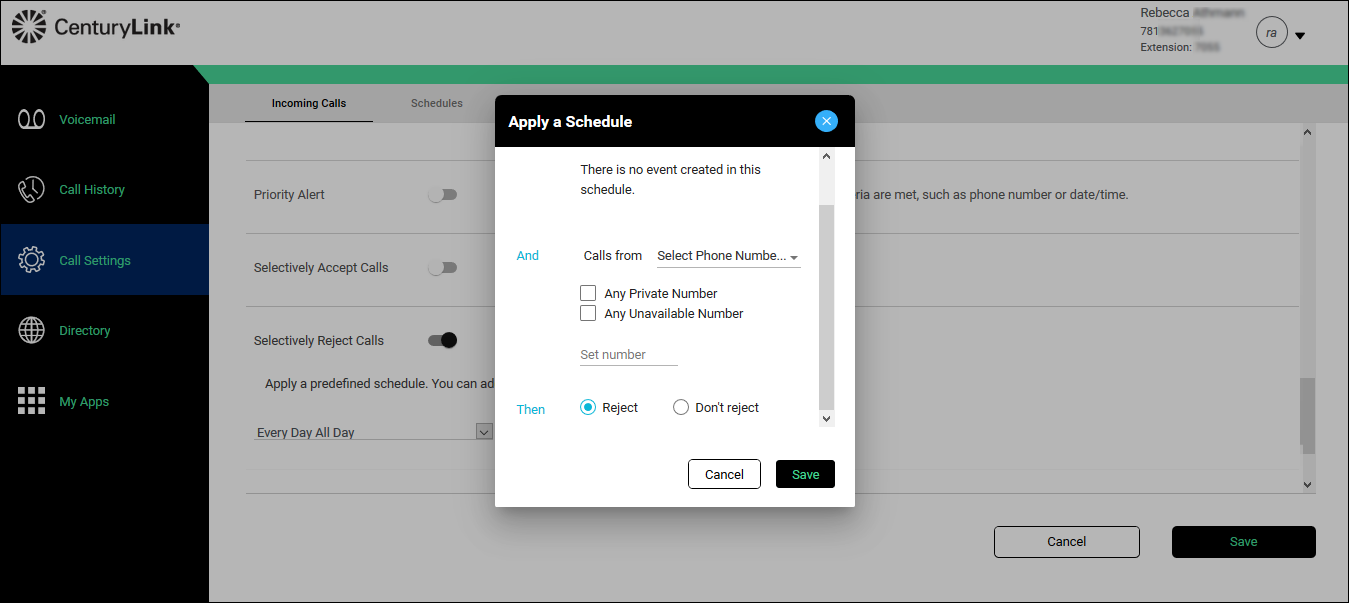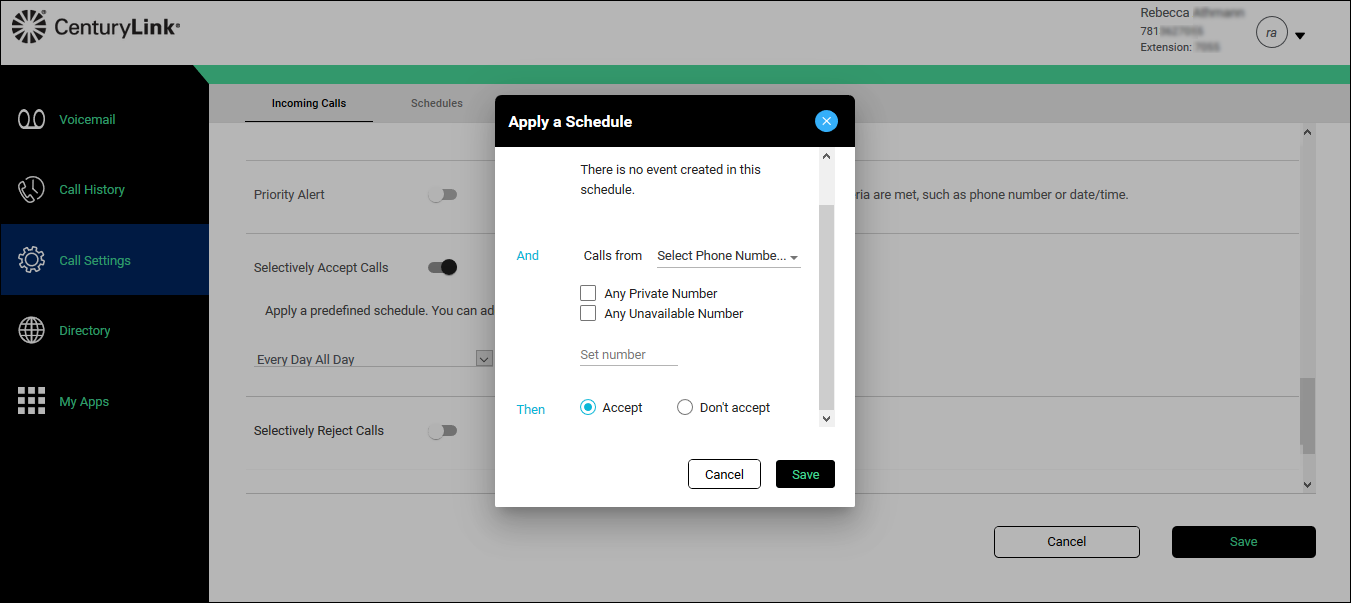We no longer support this browser. For an optimal experience, we recommend updating your browser.
Manage calling features from the user portal
Anonymous Call Rejection allows you to block incoming calls that don’t provide caller ID. The caller will hear a busy tone.
Barge In creats a three-way call by allowing you to barge in on a call in progress. The default setting for this feature is off. Find this feature under the Additional Features tab.
Block My Caller ID for Forwarded Calls lets you block your identity when you receive a transferred or forwarded call. By default this feature is turned off, and should remain in the off position. Find this feature under the Additional Features tab.
Business Continuity allows you to conduct business if you’re unable to access the network due a natural disaster or power outage. Use this feature to direct incoming calls to any other phone.
Call Forwarding allows you to send calls to another phone. You can choose to forward all your calls when your line is busy or you are unable to answer calls.
Call Notify sends you an email with the incoming call information.
Call Waiting allows you to receive and answer additional calls while you're on an active call. If it's turned off, new calls will be sent to voicemail.
Do Not Disturb sends calls directly to your voicemail until you turn it off.
Office Anywhere allows you to receive calls on another device, such as a cell phone. You can also move calls between your handset and mobile phone.
Priority Alert gives your phone a distinctive ring when receiving calls from specified numbers. You can define the phone number and date and time of the call you want to be alerted to. You can set a schedule for this feature.
Remote Office lets you use an alternate phone, such as your mobile or home phone, as your business phone. When the feature is on, your office number will appear in the caller ID.
Selectively Accept Calls lets you accept incoming calls based on the phone number or a schedule. You can set a schedule for this feature.
Selectively Reject Calls lets you reject incoming calls based on the phone number or a schedule. You can set a schedule for this feature.
Selectively Forward Calls lets you forward calls from specific callers or at regular times. This setting takes precedence over Call Forwarding. You can set a schedule for this feature.
Sequential Ring allows you to pass incoming calls along to up to five phones, one after another.
Simultaneous Ring allows up to 10 phones to ring, all at the same time, until one is answered.
To access calling features from the user portal
2. Open the Voicemail tab
3. Click Voicemail Settings

- Click the Call Settings tab. The Incoming Calls tab opens.
- Scroll down to find the feature you'd like to turn on or off and change the toggle.

These features have further instructions for set-up:
Call Forwarding
- Select a checkbox for Always, When busy, or When no answer.
- In the Set number field, type the number you’re forwarding to.
- From the Number of rings before forwarding list, select the number of rings you want callers to hear before they are transferred. (We recommend selecting 2-3 rings.)
- Select the Use ring reminder checkbox to hear a short ring when you receive a call, to remind you Call Forwarding is on.
- Click Save.
Note: By default, calls go directly to voicemail if your line is busy or calls are unanswered. Typically, you don’t change these settings, but you can if needed.
Call Notify
- In the Set email address field, type your email address.
- Select Every Day All Day if you want the schedule to apply all day during every day.
- Add a schedule.

Office Anywhere
- If you want all Anywhere devices to ring when you Click-to-Dial from the user portal, select the Alert all enabled “Locations” for Click to Dial checkbox.
- Click Add Another “Location” to add an Anywhere device.
Additional devices can be added by clicking Add Another Location, then do the following (only one device must be defined for the feature to work):
- In the Name field, type a description for the device, such as cell phone.
- In the Phone Number field, type the phone number for the Anywhere device you’re defining.
If you no longer want to send calls to a phone number, click Delete.
- In the Name field, type a description for the device, such as cell phone.
- Click Save.
Sequential Ring
- In the 1. Set number field, type the first number you want to ring. (Continue to add numbers in the order you want the calls to ring to.)
- From the Rings list, select the number of rings at each phone before moving to the next phone.
- If you want the person who answers the call to press a key to be connected, select the Answer Confirmation checkbox. Typically, this setting is off.
- To have your business phone ring first, select the Ring base location first checkbox, then from the Number of rings list, select the number of times the phone needs to ring without being answered before moving to the next number.
The number of rings should be less than the number of rings set for the call to go to voicemail when a call is not answered. If this setting is not lower, the caller will never go to the next location. When designing your sequential ring path, keep in mind callers won’t remain on the line for more than a few rings.
- When your business line is busy and you want incoming calls to follow the sequential ring path, select the Continue if base location is busy checkbox.
- For unanswered calls to go to voicemail, select the Enable caller to go to voicemail checkbox.
- If you want Sequential Ring to follow a schedule, change the Apply Schedule toggle to on.
Schedules can be added or modified from the Schedules tab.
Simultaneous Ring
- If you do not want your phone to ring when you’re on a call, deselect the Do not ring when on a call checkbox. (By default, your phone will not ring.)
- In the Set number field, type the number for the phone you want to simultaneously ring for incoming calls.
- If you want to require the person who answers the call to press a key to be connected, select the Answer Confirmation checkbox. (This is typically not used.)
- If you want Simultaneous Ring to follow a schedule, change the Apply Schedule toggle to on.
Schedules can be added or modified from the Schedules tab.
Schedule
- From the Every Day All Day list, do one of the following:
- Select Every Day All Day if you want the schedule to apply all day during every day.
- Select AUTOATTENDANT-BUSINESS-HOURS if you want the schedule to apply to the auto attendant during business hours.
- Select Every Day All Day if you want the schedule to apply all day during every day.

- Click Add Schedule.
- In the And section, from the Calls from list, do one of the following:
- Select Any Phone Number if you want all calls to follow the schedule.
- Select Select Phone Numbers if you want certain calls to follow the schedule, then do any of the following:
- Select the Any Private Number checkbox for all private numbers to follow the schedule.
- Select the Any Unavailable Number checkbox for calls without caller ID to follow the schedule.
- In the Set Number field, type individual numbers you want to follow the schedule.
- Select the Any Private Number checkbox for all private numbers to follow the schedule.
- Select Any Phone Number if you want all calls to follow the schedule.

- In the Then section, do one of the following:
- Select the Notify me radio button if you want to be notified.
- Select the Don't notify me radio button if you don’t need to be notified.
- Select the Notify me radio button if you want to be notified.
- Click Save.
Did you find the help you were looking for today?
